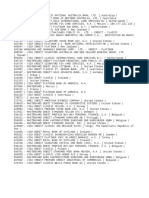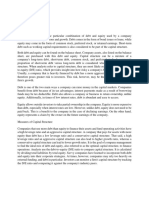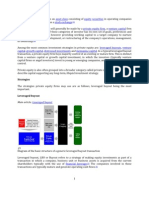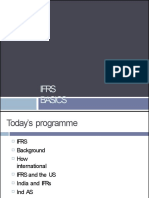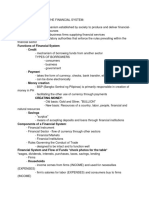Vanraj Samrt Task 1
Vanraj Samrt Task 1
Uploaded by
Vanraj MakwanaCopyright:
Available Formats
Vanraj Samrt Task 1
Vanraj Samrt Task 1
Uploaded by
Vanraj MakwanaCopyright
Available Formats
Share this document
Did you find this document useful?
Is this content inappropriate?
Copyright:
Available Formats
Vanraj Samrt Task 1
Vanraj Samrt Task 1
Uploaded by
Vanraj MakwanaCopyright:
Available Formats
VCE Summer Internship Program 2020
Smart Task Submission Format
[ Download This Format in .DOCX format and then Edit it and SUBMIT]
Intern’s Details
Name Vanraj Makwana
Email-ID Vanraj.bepf22@bkschool.org.in
Smart Task No. 1
Project Topic Project Finance – Modeling and Analysis
Smart Task (Solution)
Task Q1: What is Finance? How Finance is different from Accounting? What are
important basic points that should be learned to pursue a career in finance?
Task Q1 Solution:
Finance - It is a term for matters regarding the management, creation, and study
of money and investments Specifically, it deals with the questions of how and why an
individual, company or government acquire the money needed – called capital in the company
context – and how they spend or invest that money. Finance is then often split into the following
major categories: corporate finance, personal finance and public finance.
Finance vs Accounting - accounting focuses on the day-to-day flow of money in and out of a
company or institution, whereas finance is a broader term for the management of assets and
liabilities and the planning of future growth.
Important Points –
Accounting Knowledge
Interpersonal skills. ...
Ability to communicate. ...
Financial reporting. ...
Analytical ability. ...
Knowledge of IT software. ...
Management experience. ...
Commercial acumen.
500 Words (Max.)
Task Q2: What is project finance? How is project finance different from
corporate finance? Why can’t we put project finance under corporate finance?
ST Solution Page 1 https://techvardhan.com
VCE Summer Internship Program 2020
Smart Task Submission Format
Task Q2 Solution:
Project Finance - Project finance refers to the funding of long-term projects, such as public
infrastructure or services, industrial projects, and others through a specific financial structure. The
cash flows from the project enable servicing of the debt and repayment of debt and equity.
Project Finance vs Corporate Finance -
Attribute Corporate Finance Project Finance
Availed during the inception of a Availed by established SPVs venturing into
Stage
company and during any expansion new projects
The basis for
Balance sheet, cash flow, and overall Project feasibility analysis, project asset
credit
financial health of the company value, and forecasted cashflow
evaluation
Risk is common and consolidated. Any Risk is restricted and ringfenced to the
Risk bad project may affect the over project and does not spill over to other
operations of the business entity businesses/projects.
Returns are Moderate as risk and
Returns Returns are high as the risk is high
returns are shared.
Overall assets/cash flows of the Limited to only the project assets/cash
Collateral
company flows
Permanent and exists throughout the Finite and limited to only the lifespan of the
Type of capital
life of the company project
Reinvestment from revenue is not allowed
Least restrictive covenants by the
Reinvestment and have to be adhered to as per the
participants, mostly regulatory
sanctioned conditions of the participants.
Financial Common and Simple financial Tailormade financial structures that vary
structure structures from case to case.
Transaction Low cost due to risk-sharing and Higher costs due to tailor-made
costs simple structure documentation requirements.
Financial Higher financial flexibility due to less Low Financial flexibility due to highly
elasticity restrictive covenants restrictive covenants.
Why can’t we out Project Finance under Corporate Finance –
Project finance greatly minimizes risk to the sponsoring company, as compared to
traditional corporate finance, because the lender relies only on the project revenue to repay the
loan and cannot pursue the sponsoring company's assets in the case of default.
500 Words (Max.)
Task Q3: Define 20 terminologies related to project finance.
Task Q3 Solution:
1. Amortization: Amortization is a method of spreading an intangible asset's cost over the course
ST Solution Page 2 https://techvardhan.com
VCE Summer Internship Program 2020
Smart Task Submission Format
of its useful life. Intangible assets are non-physical assets that are essential to a company, such as
a trademark, patent, copyright, or franchise agreement.
2. Assets: Assets are items you own that can provide future benefit to your business, such as
cash, inventory, real estate, office equipment, or accounts receivable, which are payments due to a
company by its customers. There are different types of assets, including:
Current Assets: Which can be converted to cash within a year
Fixed Assets: Which can’t immediately be turned into cash, but are tangible items that a
company owns and uses to generate long-term income
3. Asset Allocation: Asset allocation refers to how you choose to spread your money across
different investment types, also known as asset classes. These include:
Bonds: Bonds represent a form of borrowing. When you buy a bond, typically from the
government or a corporation, you’re essentially lending them money. You receive periodic
interest payments and get back the loaned amount at the time of the bond’s maturity—or
the defined term at which the bond can be redeemed.
Stocks: A stock is a share of ownership in a public or private company. When you buy
stock in a company, you become a shareholder and can receive dividends—the
company’s profits—if and when they are distributed.
Cash and Cash Equivalents: This refers to any asset in the form of cash, or which can
be converted to cash easily in the event it's necessary.
4. Balance Sheet: A balance sheet is an important financial statement that communicates an
organization’s worth, or “book value.” The balance sheet includes a tally of the organization’s
assets, liabilities, and shareholders’ equity for a given reporting period.
The Balance Sheet Equation: Balance sheets are arranged according to the following
equation: Assets = Liabilities + Owners’ Equity
5. Capital Gain: A capital gain is an increase in the value of an asset or investment above the price
you initially paid for it. If you sell the asset for less than the original purchase price, that would be
considered a capital loss.
6. Capital Market: This is a market where buyers and sellers engage in the trade of financial
assets, including stocks and bonds. Capital markets feature several participants, including:
Companies: Firms that sell stocks and bonds to investors
Institutional investors: Investors who purchase stocks and bonds on behalf of a large
capital base
Mutual funds: A mutual fund is an institutional investor that manages the investments of
thousands of individuals
Hedge funds: A hedge fund is another type of institutional investor, which controls risk
ST Solution Page 3 https://techvardhan.com
VCE Summer Internship Program 2020
Smart Task Submission Format
through hedging—a process of buying one stock and then shorting a similar stock to
make money from the difference in their relative performance
7. Cash Flow: Cash flow refers to the net balance of cash moving in and out of a business at a
specific point in time. Cash flow is commonly broken into three categories, including:
Operating Cash Flow: The net cash generated from normal business operations
Investing Cash Flow: The net cash generated from investing activities, such as
securities investments and the purchase or sale of assets
Financing Cash Flow: The net cash generated financing a business, including debt
payments, shareholders’ equity, and dividend payments
8. Cash Flow Statement: A cash flow statement is a financial statement prepared to provide a
detailed analysis of what happened to a company’s cash during a given period of time. This
document shows how the business generated and spent its cash by including an overview of cash
flows from operating, investing, and financing activities during the reporting period.
9. Compound Interest: This refers to “interest on interest.” Rather, when you’re investing or
saving, compound interest is earned on the amount you deposited, plus any interest you’ve
accumulated over time. While it can grow your savings, it can also increase your debt; compound
interest is charged on the initial amount you were loaned, as well as the expenses added to your
outstanding balance over time.
10. Depreciation: Depreciation represents the decrease in an asset’s value. It’s a term commonly
used in accounting and shows how much of an asset’s value a business has used over a period of
time.
11. EBITDA: An acronym standing for Earnings Before Interest, Taxes, Depreciation, and
Amortization, EBITDA is a commonly used measure of a company’s ability to generate cash flow.
To get EBITDA, you would add net profit, interest, taxes, depreciation, and amortization together.
12. Equity: Equity, often called shareholders’ equity or owners’ equity on a balance sheet,
represents the amount of money that belongs to the owners of a business after all assets and
liabilities have been accounted for. Using the accounting equation, shareholder’s equity can be
found by subtracting total liabilities from total assets.
13. Income Statement: An income statement is a financial statement that summarizes a
business’s income and expenses during a given period of time. An income statement is also
sometimes referred to as a profit and loss (P&L) statement.
14. Liabilities: The opposite of assets, liabilities are what you owe other parties, such as bank
debt, wages, and money due to suppliers, also known as accounts payable. There are different
ST Solution Page 4 https://techvardhan.com
VCE Summer Internship Program 2020
Smart Task Submission Format
types of liabilities, including:
Current Liabilities: Also known as short-term liabilities, these are what’s due in the next
year
Long-Term Liabilities: These are financial obligations not due over a year that can be
paid off over a longer period of time
15. Liquidity: Liquidity describes how quickly your assets can be converted into cash. Because of
that, cash is the most liquid asset. The least liquid assets are items like real estate or land, because
they can take weeks or months to sell.
16. Net Worth: You can calculate net worth by subtracting what you own, your assets, with what
you owe, your liabilities. The remaining number can help you determine the overall state of your
financial health.
17. Profit Margin: Profit margin is a measure of profitability that’s calculated by dividing the net
income by revenue or the net profit by sales. Companies often analyze two types of profit margins:
Gross Profit Margin: Which typically applies to a specific product or line item rather than
an entire business
Net Profit Margin: Which typically represents the profitability of an entire company
18. Return on Investment (ROI): Return on Investment is a simple calculation used to determine
the expected return of a project or activity in comparison to the cost of the investment, typically
shown as a percentage. This measure is often used to evaluate whether a project will be
worthwhile for a business to pursue. ROI is calculated using the following equation: ROI = [(Income
- Cost) / Cost] * 100
19. Valuation: Valuation is the process of determining the current worth of an asset, company, or
liability. There are a variety of ways you can value a business, but regularly repeating the process
is helpful, because you’re then ready if ever faced with an opportunity to merge or sell your
company, or are trying to seek funding from outside investors.
20. Working Capital: Also known as net working capital, this is the difference between a
company’s current assets and current liabilities. Working capital—the money available for daily
operations—can help determine an organization’s operational efficiency and short-term financial
health.
500 Words (Max.)
Task Q4: What is non-recourse debt / loan? What is mezzanine finance
ST Solution Page 5 https://techvardhan.com
VCE Summer Internship Program 2020
Smart Task Submission Format
explained with an example
Task Q4 Solution:
Non-recourse debt/loan – A non-recourse debt/loan more broadly, is any consumer or
commercial debt that is secured only by collateral. In case of default, the lender may not
seize any assets of the borrower beyond the collateral. A mortgage loan is typically a non-
recourse loan.
Mezzanine Finance - Mezzanine financing is a hybrid of debt and equity financing that gives the
lender the right to convert to an equity interest in the company in case of default, generally, after
venture capital companies and other senior lenders are paid.
Example – Let us assume you want to start your own business and you need $ 15 million. You
plan to rise $5 million through equity and approached a bank seeking a loan of $10 million.
However, a bank will usually deem it as unreasonable and will lend only 755 of the required loan. It
leaves you with an option it raise $7.5 million through equity.
Suppose a mezzanine investor proposes to lend you $5 million. Since the bank
considers mezzanine as equity and sees a trusted partner with the mezzanine component, the
bank will ultimately lend you the original requested amount of $10 million. Therefore, the total
capital raised with and without mezzanine will be:
500 Words (Max.)
Task Q5: Explain in detail with reasons of what the sectors are or which type of
projects are suitable for project finance?
Task Q5 Solution:
A project finance arrangement is a structured finance scheme based on the long-term cash-flows
generated by an enterprise incorporated for an isolated project, taking as collateral said enterprise’s
assets. The truly differentiating element of a project finance arrangement is that it is structured
based on the long-term predictability of its cash flows in accordance with a structure of fixed
contracts with its customers, suppliers, market regulators, etc.
Appropriate project finance candidates include green field projects and significant facility or
ST Solution Page 6 https://techvardhan.com
VCE Summer Internship Program 2020
Smart Task Submission Format
production expansions. These projects do not rely on the typical export finance security package,
which provide lenders recourse to a foreign government, financial institution or an established
corporation.
Share capital – equity capital and preference capital.
Term loan
Debenture capital
Commercial banks
Bills discounting
500 Words (Max.)
Please add /delete blocks for if needed.
ST Solution Page 7 https://techvardhan.com
You might also like
- Citi Bank 2021 StatementsDocument2 pagesCiti Bank 2021 StatementsJohn call67% (3)
- BP Amoco CaseDocument37 pagesBP Amoco CaseIlayaraja DhatchinamoorthyNo ratings yet
- Bin CCDocument1 pageBin CCShania Eka Puspasari100% (1)
- Finance Compendium PartI DMS IIT DelhiDocument29 pagesFinance Compendium PartI DMS IIT Delhinikhilkp9718No ratings yet
- Why Do Sponsors Use Project Finance?: 2. How Does Project Finance Create Value? Justify With An ExampleDocument3 pagesWhy Do Sponsors Use Project Finance?: 2. How Does Project Finance Create Value? Justify With An Examplekumsisa kajelchaNo ratings yet
- Short Questions FMDocument21 pagesShort Questions FMsultanrana100% (1)
- FOF Tutorial 9 AnsDocument6 pagesFOF Tutorial 9 AnsYasmin Zainuddin100% (1)
- LEVEL 1-2-2015 New SyllDocument100 pagesLEVEL 1-2-2015 New SyllEmilyNo ratings yet
- Remittance Application Form ICBC LondonDocument2 pagesRemittance Application Form ICBC LondonDennis tang100% (1)
- Vce Smart Task 1 (Project Finance)Document7 pagesVce Smart Task 1 (Project Finance)Ronak Jain100% (5)
- Name Smart Task No. Project TopicDocument7 pagesName Smart Task No. Project TopicMd FarmanNo ratings yet
- Pratibha Singh - VCE Task1Document5 pagesPratibha Singh - VCE Task1Pratibha SinghNo ratings yet
- Smart Task 1 SubmissionDocument8 pagesSmart Task 1 SubmissionPrateek JoshiNo ratings yet
- VCE Summer Internship Program 2020: Smart Task Submission FormatDocument5 pagesVCE Summer Internship Program 2020: Smart Task Submission FormatAbhishek DongreNo ratings yet
- VCE Summer Internship Program 2020: Ruchit GuptaDocument5 pagesVCE Summer Internship Program 2020: Ruchit Guptaruchit guptaNo ratings yet
- Project Finance Smart TaskDocument5 pagesProject Finance Smart TaskYASHASVI SHARMANo ratings yet
- Smart Task 1Document6 pagesSmart Task 1Krishnaja PrakashNo ratings yet
- VCE Summer Internship Program 2021: Rishav Raj Gupta 1 Financial Modeling and AnalysisDocument6 pagesVCE Summer Internship Program 2021: Rishav Raj Gupta 1 Financial Modeling and AnalysisRISHAV RAJ GUPTANo ratings yet
- Mrunalini's Task-1Document5 pagesMrunalini's Task-1Pampana Bala Sai Saroj RamNo ratings yet
- Question 1. What Is Finance? How Finance Is Different From Accounting? What Are Important BasicDocument4 pagesQuestion 1. What Is Finance? How Finance Is Different From Accounting? What Are Important BasicParmarth KhannaNo ratings yet
- Smart Task 1Document13 pagesSmart Task 1devesh bhattNo ratings yet
- VCE Summer Internship Program 2021: Smart Task Submission FormatDocument5 pagesVCE Summer Internship Program 2021: Smart Task Submission FormatRohan SomaniNo ratings yet
- What Is FinanceDocument6 pagesWhat Is FinanceMiral Sandipbhai MehtaNo ratings yet
- Task 1Document6 pagesTask 1Ayushi GuptaNo ratings yet
- R29 Sources of CapitalDocument12 pagesR29 Sources of CapitalSumair ChughtaiNo ratings yet
- Vardhan Consulting Finance Internship Task 1Document6 pagesVardhan Consulting Finance Internship Task 1Ravi KapoorNo ratings yet
- What Is Finance? How Finance Is Different From Accounting? What AreDocument4 pagesWhat Is Finance? How Finance Is Different From Accounting? What AreSoniya DhyaniNo ratings yet
- Name Email-ID Smart Task No. Project Topic: Intern's DetailsDocument4 pagesName Email-ID Smart Task No. Project Topic: Intern's DetailsKinnu RajpuraNo ratings yet
- Dire-Dawa University Institute of Technology: Construction Technology and Management Chair Course Code: byDocument34 pagesDire-Dawa University Institute of Technology: Construction Technology and Management Chair Course Code: bySemNo ratings yet
- Project Finance - How It Works, Definition, and Types of LoansDocument7 pagesProject Finance - How It Works, Definition, and Types of LoansP H O E N I XNo ratings yet
- Investment Banking PDFDocument17 pagesInvestment Banking PDFjelagi3068No ratings yet
- Financial ManagementDocument26 pagesFinancial ManagementbassramiNo ratings yet
- Bpe 34603 - LN 5 25 March 2019Document28 pagesBpe 34603 - LN 5 25 March 2019Irfan AzmanNo ratings yet
- Top 30 Investment Banking Interview Questions and AnswersDocument7 pagesTop 30 Investment Banking Interview Questions and AnswersVidit ParuthiNo ratings yet
- Bus. Finance 2. Final 2.Document9 pagesBus. Finance 2. Final 2.Gia PorqueriñoNo ratings yet
- LM05 Working Capital & LiquidityDocument16 pagesLM05 Working Capital & LiquiditySYED HAIDER ABBAS KAZMINo ratings yet
- Vce ST01 FMDocument4 pagesVce ST01 FMSourabh ChiprikarNo ratings yet
- Business EnvironmentDocument14 pagesBusiness EnvironmentBensonOTJr.No ratings yet
- 3 2SourcesofFinanceUpdatedDocument12 pages3 2SourcesofFinanceUpdatedKLNo ratings yet
- FM Viva AnsersDocument9 pagesFM Viva AnsersRishabh SinghNo ratings yet
- FM Pointers For ReviewDocument12 pagesFM Pointers For ReviewAngelyne GumabayNo ratings yet
- Report Doc 1Document24 pagesReport Doc 1ralekhya33No ratings yet
- PMF Unit 5Document10 pagesPMF Unit 5dummy manNo ratings yet
- Venture Capital MeaningDocument5 pagesVenture Capital MeaningrhythmkannanNo ratings yet
- Module 3Document32 pagesModule 3Dr.Shaifali GargNo ratings yet
- Smart Task 01 - VCEDocument3 pagesSmart Task 01 - VCEHarshit AroraNo ratings yet
- Task 3Document5 pagesTask 3Pampana Bala Sai Saroj RamNo ratings yet
- Sanjid Mamhud - 201803067 - Working Capital Policy - Assignment 1Document5 pagesSanjid Mamhud - 201803067 - Working Capital Policy - Assignment 1Sanjid Mahmud SwarupNo ratings yet
- Finance Exam NotesDocument14 pagesFinance Exam NotesAneesha100% (2)
- Financial ManagementDocument21 pagesFinancial ManagementsumanNo ratings yet
- Rupanshi Goel (ST 1)Document3 pagesRupanshi Goel (ST 1)Puneet Singh DhaniNo ratings yet
- Financial Management and Securities MarketsDocument6 pagesFinancial Management and Securities MarketsKomal RahimNo ratings yet
- Vardhan Consulting Engineers (VCE) Summer Internship Program 2020Document4 pagesVardhan Consulting Engineers (VCE) Summer Internship Program 2020Riya VermaNo ratings yet
- Basic of AccountingDocument9 pagesBasic of AccountingAbhishek Kumar100% (1)
- FM 4 Group 11Document14 pagesFM 4 Group 11Bea Nicole ReyesNo ratings yet
- VCE InternshipsDocument6 pagesVCE Internshipsabhishek100% (1)
- Module 1 Task 1 VceDocument10 pagesModule 1 Task 1 VcevedantNo ratings yet
- I & E FinanceDocument37 pagesI & E FinanceDeepak GuptaNo ratings yet
- Financial Management A-Part 5th SEMV1Document20 pagesFinancial Management A-Part 5th SEMV1arunpradeep795No ratings yet
- CHP 1 NTRO ADVANCED FINANCIAL MANAGEMENTDocument4 pagesCHP 1 NTRO ADVANCED FINANCIAL MANAGEMENTcuteserese roseNo ratings yet
- AgroAfrica - projectfinancing-201106054348Document15 pagesAgroAfrica - projectfinancing-201106054348Herbert Marcelo de AndradeNo ratings yet
- Ê, in Finance, Is AnDocument11 pagesÊ, in Finance, Is AnJome MathewNo ratings yet
- Project Finance (Smart Task 1)Document14 pagesProject Finance (Smart Task 1)Aseem VashistNo ratings yet
- Textbook of Urgent Care Management: Chapter 46, Urgent Care Center FinancingFrom EverandTextbook of Urgent Care Management: Chapter 46, Urgent Care Center FinancingNo ratings yet
- Role of Reserve Bank in Indian Banking System: Conference PaperDocument11 pagesRole of Reserve Bank in Indian Banking System: Conference PaperVanraj MakwanaNo ratings yet
- Assignment - ML - Python Developer-2Document1 pageAssignment - ML - Python Developer-2Vanraj MakwanaNo ratings yet
- Data Engineering Road MapDocument1 pageData Engineering Road MapVanraj MakwanaNo ratings yet
- FM Assignment 2 EPF13 VanrajDocument10 pagesFM Assignment 2 EPF13 VanrajVanraj MakwanaNo ratings yet
- Vanraj Smart Task 2Document4 pagesVanraj Smart Task 2Vanraj MakwanaNo ratings yet
- Budget Wheel: Monthly ExpensesDocument2 pagesBudget Wheel: Monthly ExpensesRitik RajNo ratings yet
- Struktur Organisasi Pt. Bank Mandiri (Persero) Cabang Palu: Gambar 4.1Document1 pageStruktur Organisasi Pt. Bank Mandiri (Persero) Cabang Palu: Gambar 4.1Ismail AbdullahNo ratings yet
- Chapter 3 Review PDFDocument5 pagesChapter 3 Review PDFAisha KhanNo ratings yet
- Financial and Monetary Policies in Ghana: A Review of Recent TrendsDocument11 pagesFinancial and Monetary Policies in Ghana: A Review of Recent TrendsrytchluvNo ratings yet
- ABC Law FirmDocument7 pagesABC Law FirmMuhammad Bin AshrafNo ratings yet
- How Do Small Business Loans Work?Document3 pagesHow Do Small Business Loans Work?Soumyajit Das MazumdarNo ratings yet
- IFRS BasicsDocument86 pagesIFRS BasicsManisha DeyNo ratings yet
- E/ Izns'K HKKST Eqdr Fo'Ofo - Ky ) Hkksiky: Madhya Pradesh Bhoj (Open) University, BhopalDocument6 pagesE/ Izns'K HKKST Eqdr Fo'Ofo - Ky ) Hkksiky: Madhya Pradesh Bhoj (Open) University, BhopalPushpendra SinghNo ratings yet
- Basic Elements of The Financial SystemDocument3 pagesBasic Elements of The Financial SystemJessa ArellagaNo ratings yet
- CH 32Document2 pagesCH 32Mukul KadyanNo ratings yet
- Partnerships: Formation, Operation, and Ownership Changes: Multiple ChoiceDocument20 pagesPartnerships: Formation, Operation, and Ownership Changes: Multiple ChoiceLester AlpanoNo ratings yet
- Mbaf0701 - Far - SyllabusDocument2 pagesMbaf0701 - Far - SyllabusRahulNo ratings yet
- Neo Axel M. - TMP108 Prelim ExamDocument4 pagesNeo Axel M. - TMP108 Prelim ExamAxel NeoNo ratings yet
- Executive Summary: Lovely Professional University, JalandharDocument64 pagesExecutive Summary: Lovely Professional University, JalandharRajnish KumarNo ratings yet
- Calculating CRAR & Capital Adequacy Ratio: Prof.b.p.mishra XimbDocument21 pagesCalculating CRAR & Capital Adequacy Ratio: Prof.b.p.mishra XimbSudhansuSekhar100% (1)
- 2019 Prime MFDocument85 pages2019 Prime MFAsad EwsalNo ratings yet
- Agustina Cordero Dianne Donato Rizalyn Sansaet Jade Myrrh Angel Liz Ibañez Bsa 2A ValcomDocument11 pagesAgustina Cordero Dianne Donato Rizalyn Sansaet Jade Myrrh Angel Liz Ibañez Bsa 2A ValcomTin CorderoNo ratings yet
- Assignment Difference EquationDocument4 pagesAssignment Difference EquationSriharshitha DeepalaNo ratings yet
- Umid Customer Information RecordDocument2 pagesUmid Customer Information RecordEdaj Catabman Sotnas SoledNo ratings yet
- Second Semester First Phase Master Teaching Timetable - 2023 - 2024Document30 pagesSecond Semester First Phase Master Teaching Timetable - 2023 - 2024mwanakawesleyNo ratings yet
- Homework QuestionsDocument6 pagesHomework Questionsgaurav shetty100% (1)
- In Digismart Most Important Terms and ConditionsDocument4 pagesIn Digismart Most Important Terms and Conditionskanagu12No ratings yet
- Preliminary Considerations: Negotiable Instruments Outline IDocument9 pagesPreliminary Considerations: Negotiable Instruments Outline IKrishielle AnneNo ratings yet
- Unit 2 - Hire Purchase Accounitng - ProblemsDocument7 pagesUnit 2 - Hire Purchase Accounitng - ProblemsChethan KomarlaNo ratings yet
- Valuasi PerusahaanDocument40 pagesValuasi PerusahaanMaya Andriani A HarryNo ratings yet
- PT Royal ElektronikDocument62 pagesPT Royal ElektronikballqiisssNo ratings yet


